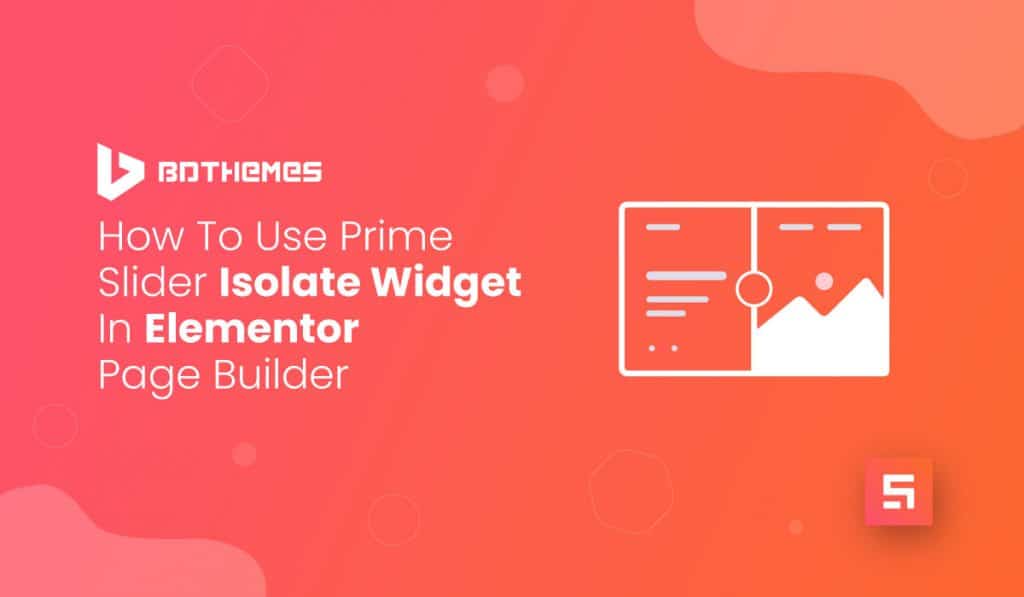The Prime Slider Isolate Widget comes with some unique features by focusing totally on visitors’ needs. The Isolate slider has a minimalistic layout with lots of white areas that keeps the readers focus on the main content. You can embed a lightbox video on top of the slider along with lots of animations.
Let’s see how this widget works!
Inserting Widget

Type Isolate in the widget search field in Elementor page builder and drag the WordPress slider inside your page. It’s super easy and fun.
Content Tab
This is the part where all the basic layout settings of the Elementor slider widget reside. You can use the sections of this tab to manipulate the layout of the Isolate slider, making your very own and unique slider for your website.
Layout
Step 1

Go to Content> Layout
Once you drag and drop the widget inside the page, you will see its first appearance along with a long list of options on your left-hand side. Basically, there’s a lot of switchers with a couple of fields and drop-down options.
The first thing you will see is the Skin option for the Isolate slider widget. There are three skins available and we will show you the default skin in this tutorial.
Then comes the custom slider dimension fields where you get to pick the height and width of your slider. The Minimum height scrollbar lets you adjust only the height of the slider widget.
The rest are switchers that can show or hide specific elements of the Isolate slider from the display.
Header
Step 1

Got to Content> Header> Logo
This section contains customization options for the header part of the slider, including logo, menu, & off-canvas. For the logo, you can select either picture or plain text.
Clicking on the Show Custom Link button, you can add a custom link to the logo instead of redirecting to the current page.
Step 2
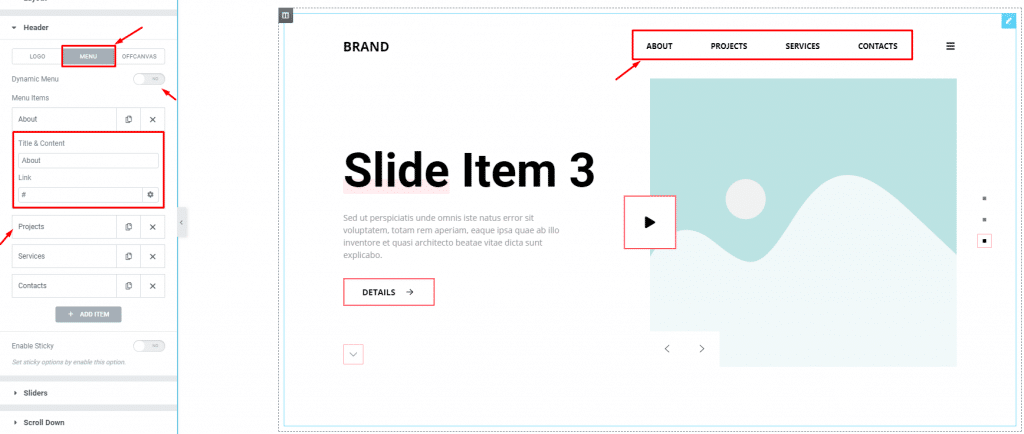
Go to Header> Menu
By clicking on the Menu sub-section, you will see the menu items and a switcher to turn on the dynamic menu. Let’s click on a menu item. There, you will see a text field and a link field. Unless providing a custom link, these menu items on the Prime Slider Isolate Widget won’t work themselves.
With the dynamic menu switcher turned on, you can select your existing menu from WordPress and add animations to it.
Step 3

Go to Header> Offcanvas
For the offcanvas menu, you can customize it by adding a custom text beside it, changing the button icon, selecting default sidebars or Elementor templates, or even go for a fully custom menu.
There are more options like offcanvas width, content after/before, and animations to further enhance the offcanvas menu on the Isolate slider.
Sliders
Step 1

Go to Content> Sliders
This section contains the slider items. You can see them on the top, followed by two options below, Image size and Image Settings. Keeping image size to the maximum will preserve the image resolution for the WordPress slider.
Also, you can change more image properties like position, attachment, repeat, and size from the image settings option.
Step 2
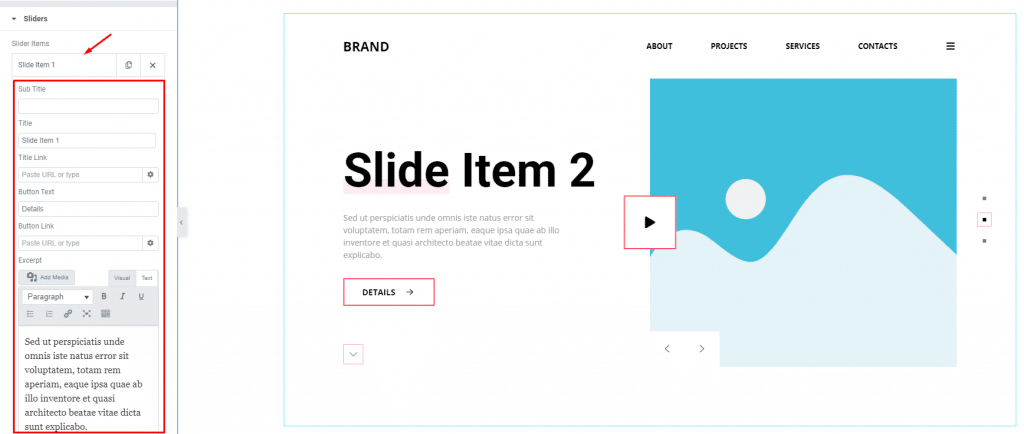
Once you click on any slider item, you will see a bunch of options unfolding for the Isolate slider widget. Here, you can put the custom text for the subtitle, title, button, link, and excerpt. Also, you can add links to the button and the title.
Step 3
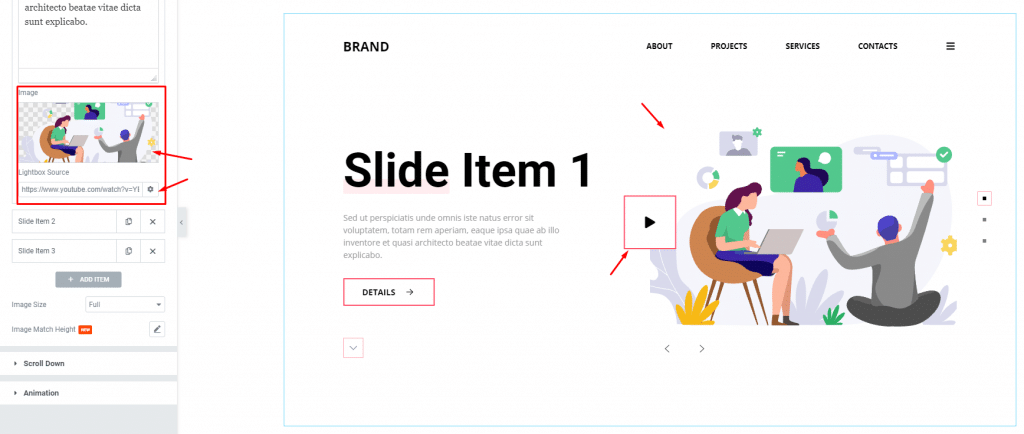
Right below the excerpt field, you can change the slider image for the selected slider item along with a custom link field for the lightbox video.
Scroll Down
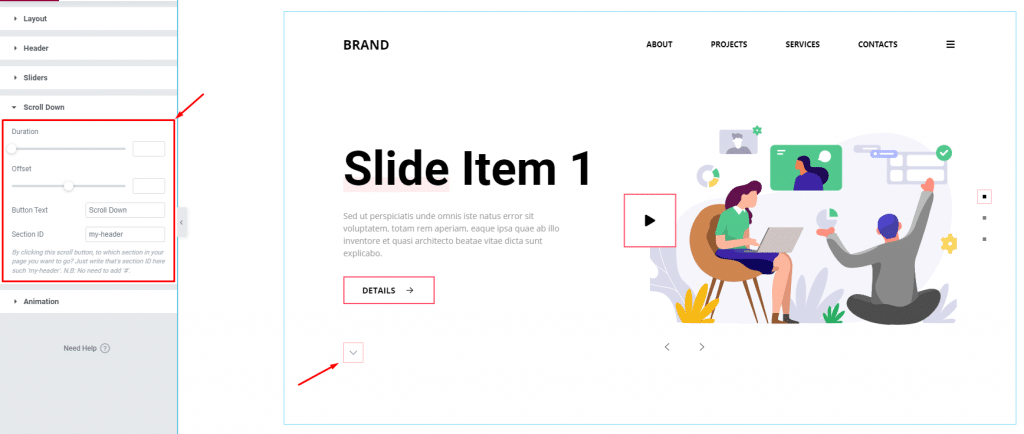
Go to Content> Scroll Down
The scroll down button takes you to any selected section away from the slider section upon click. Just put the section ID inside the field to link it. You can also set the span duration, offset value, and button text here for the Isolate slider.
Animation
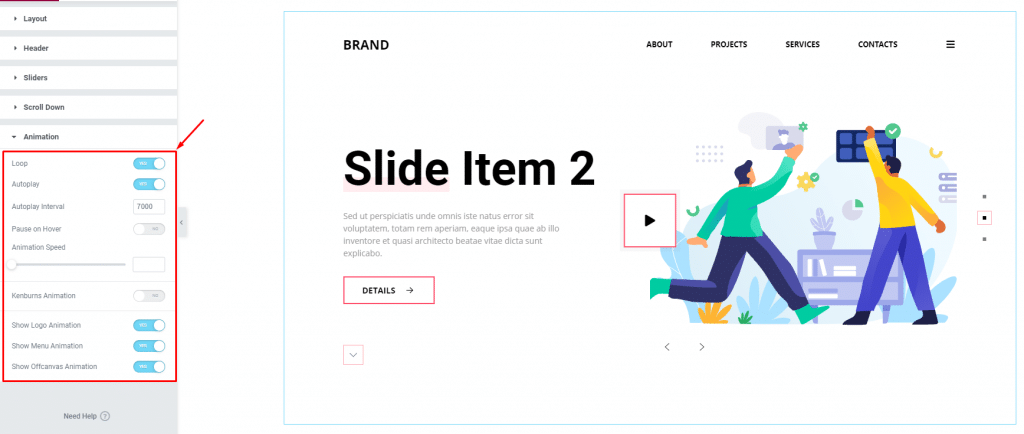
Go to Content> Animation
The last section contains all the base animation settings for the slider. There are a bunch of switchers to turn on animation loop, autoplay, parallax animation, etc. on the Prime Slider Isolate widget. The animation speed and autoplay interval time are also changeable.
By clicking on the Advanced Animation button, you can activate a jumping animation style for the subtitle, title, and except. You need to define where to activate the animation, be it on the characters, words, or lines. Also, there are more animation effects to customize by clicking the Animation options button.
There’s another animation effect available for the Elementor slider widget that reads as Kenburns animation. This is a type of zooming effect that affects the background image. Better to add slider images and then turn on this switcher to see the effects clearly.
Once you reach this section, let’s move on to the style tab to customize the Isolate slider appearance and make it look better.
Style tab
The style tab has customization options that directly change the appearance of the whole Isolate slider through color, border, typography, etc. Using these sections, you can change the look step by step, making a whole new and unique slider widget for your website.
Header
Step 1
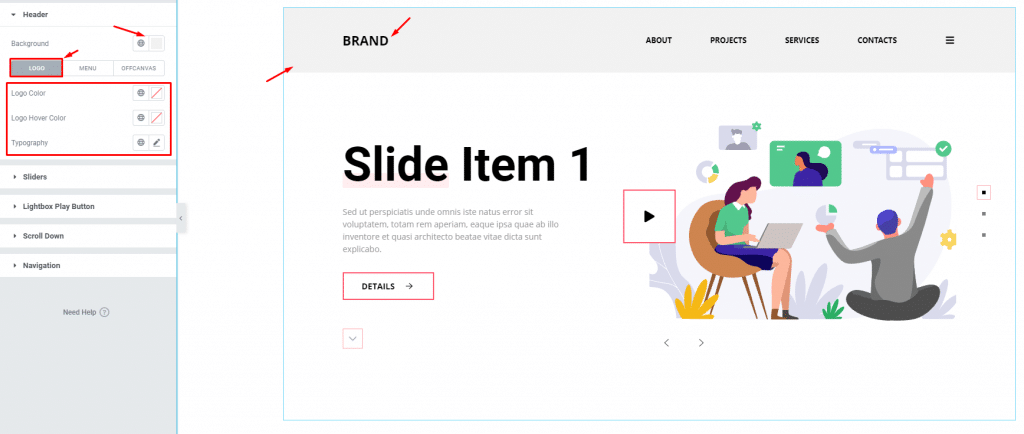
Go to Style> Header
In this section, you can pick any color for the header part from the background option on the top. Use it to make the header visible through the Isolate slider background.
Right below, the section gets divided into 3 subsections to customize the logo, menu, and offcanvas.
For the header logo, you will get color options and typography if you choose a text for the logo (from Content> Header).
Step 2
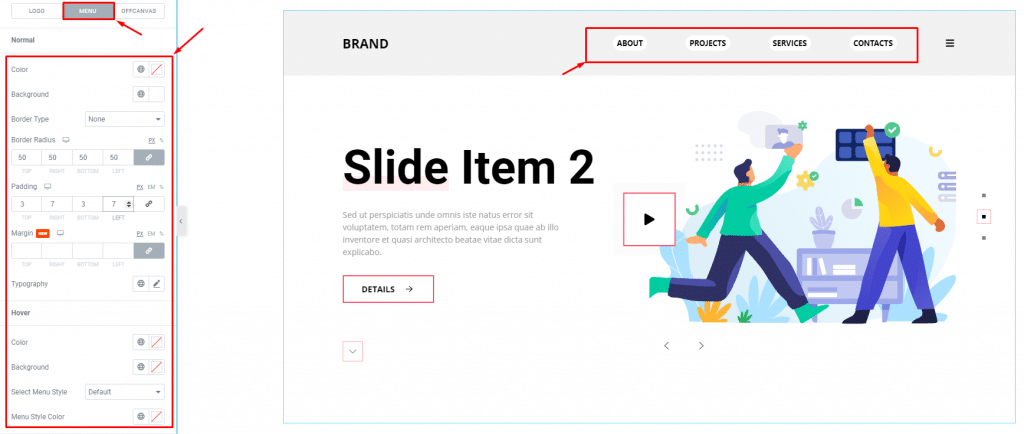
For the menu, the bunch of options available is color, background, border, border-radius, padding, margin, and typography. Using slight padding and some border radius over a lighter background color, you can highlight the Isolate slider menus easily.
The offcanvas menu has a similar setting and hence we omitted to show you the customization here.
Sliders
Step 1

Go to Style> Sliders
The first thing you will see here is the overlay option for the slider background. The overlay option is similar to photoshop where you can manipulate a lot of variables to create a more dynamic overlay color on the Isolate Slider.
Then comes the customization options for the title, subtitle, excerpt, and button; each in a separate subsection. For example, you can customize the title by changing the color and width. Also, clicking on the Text Stroke switcher will add a stroke style to the title. Notice, the text stroke option is available for the 2 parts of the title.
There’s a little line below the title which is a part of the design. You can change its color too.
Step 2
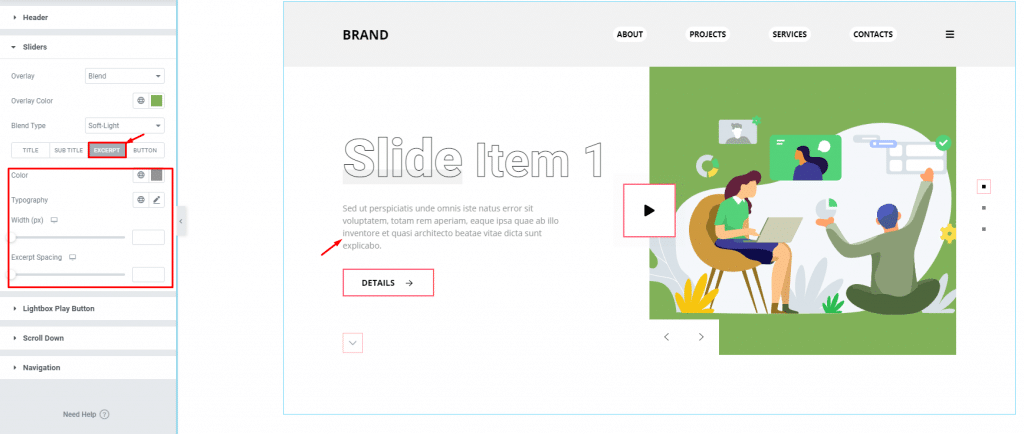
For the excerpt, you will have color, typography, and spacing options available here.
Step 3
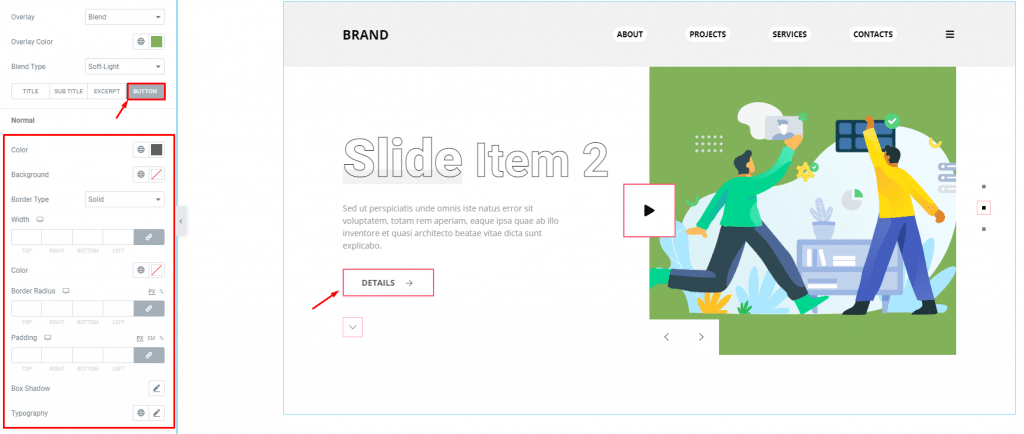
The Isolate slider button is located near the left bottom, right under the excerpt of the slider. From this subsection here, you can customize the buttons’ appearance by changing the text & background color, border & border-radius, padding, and typography.
Lightbox Play Button
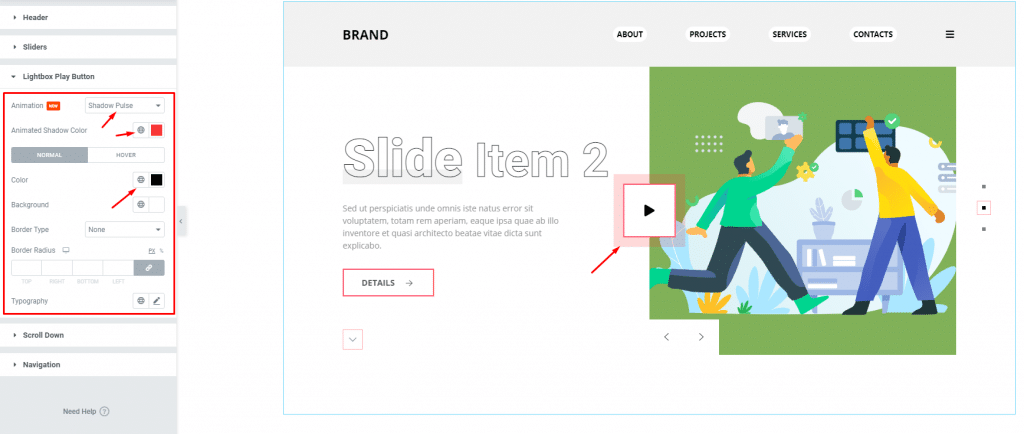
Go to Style> Lightbox Play Button
The lightbox play button for the Isolate slider is located at the center. The button has an animation style and is set to Pulse by default. You can change both the animation and the colors.
There are more options like button color, border, padding, and hover for this part. Try them to get your own style.
Scroll Button
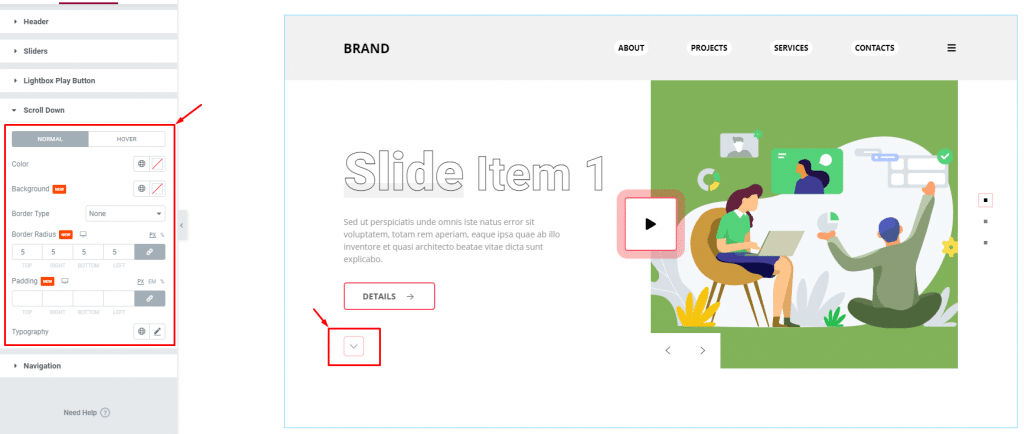
Go to Style> Scroll Button
The scroll button can be customized by changing its color, border, padding, and typography. The button has a default animation which makes it jump quite often.
Navigation
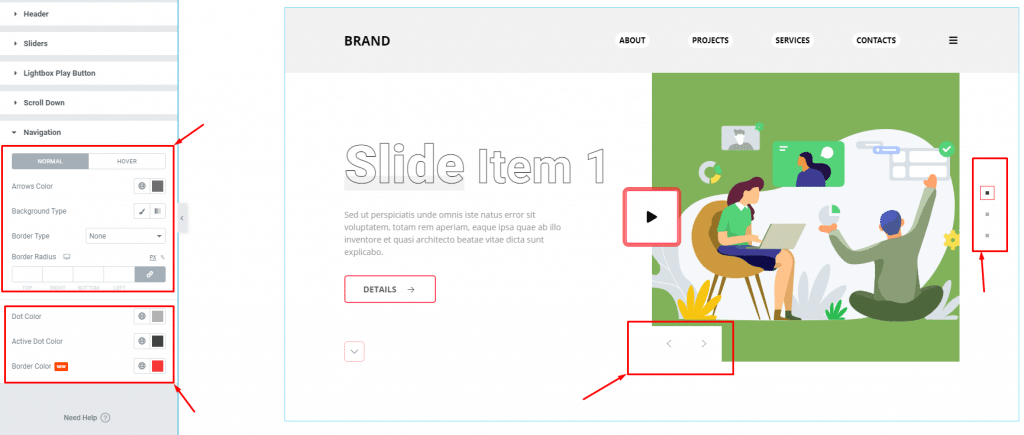
Go to Style> Navigation
There are two types of navigation systems located inside this Elementor slider widget. The arrows and the dots. With this section, you can customize the arrows navigation using color, border, border-radius, etc.
There are 3 different color options available for the dots. One goes for normal mode, one for the active mode, and the last is for the border.
Like that, you have seen all the currently available customizing options for the Prime Slider Isolate widget.
Conclusion
Confused? Watch this video to learn more visually.
This example highlights the working principle of the Isolate Widget. However, there are options for hiding certain items like- Logo, Menu, Offcanvas, Title, Sub Title, Button, Excerpt, Social, Icon, Scroll Button, Arrows, Dots, etc. Last but not least, you can place the content by setting its position left and right.
